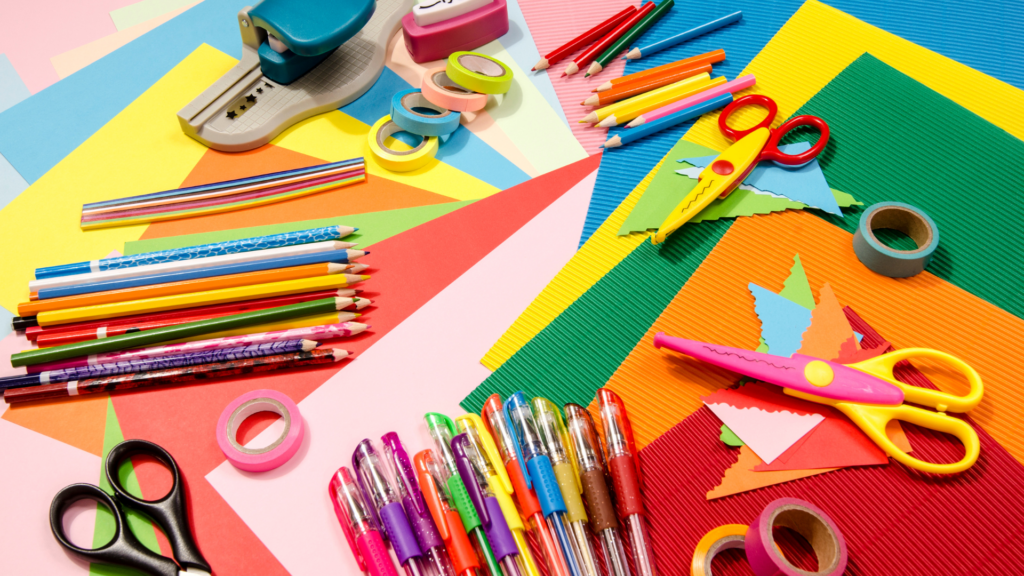Written by Liza, RSEI Educator | Published July 5th, 2023
As we all know, sex education can be a real snooze for students. Just kidding! Even though sex education is already an exciting topic, there is always space to add some fun. Below is a list of games, crafts, and other activities that can be facilitated with participants from elementary school aged to adults. There are recommended ages for each, but you know your group best! Try them with coworkers, at a crafternoon with friends, or even by yourself to unwind.
Mini Zines
all ages
First order of business, you got to learn how to make a mini zine. Everyone loves leaving with a finished product. Zines [sounds like zeens] are do-it-yourself (DIY) publications and often look like a few sheets of paper folded and stapled together, but can take on as many forms as someone can imagine. July is International Zine Month (IZM), so I absolutely had to include mini zines in this blog. Mini zines are made from just one sheet of paper and include a series of folds instead of staples to make the “binding.” You can Google “How to make a mini zine” and endless resources will be available. I’m partial to L.A. Zine Fest’s instructions in English and Spanish. They also provide a printable template. It can help to make a couple of mini zines ahead of time to show participants. Depending on time and skill level, you may want to make all of the mini zines ahead of time so participants can just write or decorate theirs, instead of trying to figure out the cutting and folding process. These are basic instructions, but be sure to look at the tutorials online:
- Fold a standard sheet of paper into 8 sections. Use your hamburger hotdog skills.
- Unfold and refold in half, hamburger style.
- This is the most difficult part – it’s okay to mess up. Cut from the middle of the fold half way across. Ending up with a slit across the middle of the paper when it’s unfolded.
- Now we’re ready to make it a zine! I like to fold the paper hotdog style and push the slit open like a mouth until it’s at a right angle from the hotdog fold. This creates the top edges. The final product should not open like an accordion, but instead like a small flimsy book.
- Confused? Somehow cut your paper all the way in half? Don’t worry, it just takes practice. It can help to look at pictures online.
The sex education fun can start once everyone has a blank mini zine. Teaching a class on relationships? Ask participants to make a “Green Flag Zine.” Instead of focusing on red flags, what are they looking for in a relationship? Remember, anytime you’re talking about relationships participants can focus on friendships or romantic relationships. If you’re talking about birth control, ask participants to make a zine dedicated to a particular method. Where can someone get the method? How well does it work? What are the side effects? Consent more your speed? Mini zines can be about how to respond and accept rejection, learning all the different ways to recognize people’s “no”, or explaining the different elements that can go into consent (we use FRIES). Mini zines are a great way to introduce topics on gender identity and sexual attraction. Check out The Pronoun Zine for an example. Zines can also be more personal (often called perzines). Invite participants to draw or write about something important to them around sexuality, like their experience with puberty or their first heartbreak or what makes them a good friend.
Visit Stolen Sharpie Revolution if you want to learn more about zines or celebrate International Zine Month. Stock your zine library through these zine distros: Brown Recluse, Wasted Ink, Antiquated Future, and Portland Button Works.
Poetry
middle school and older
While limericks have a monopoly on sexual innuendos, don’t sleep on the haiku. Traditional Japanese haikus include 17 syllables in a 5-7-5 pattern. Challenge participants to write a haiku about their feelings before starting a sex education unit and then again after completing the unit. The poets in your group may not stick to the haiku format and will explore different types of poetry. Poetry can also be used throughout sex education to not just help identify feelings, but also summarize content. For example, write a haiku about emergency contraception.
Oh No! My Condom!
Need EC but I’m broke, too.
Get to the clinic!
Of course, acrostic poems are always good in a pinch.
Love Letters
high school or adult
Light some battery operated tea candles, crank Seal’s classic Kiss From a Rose on A Grave or any rendition of I Will Always Love You by Dolly Parton, and bust out the scented stationery – It’s time to write love letters. These are not your typical love letters though. The subject of these love letters can change depending on what content you’re teaching. What would a love letter to birth control methods read like? Or lube? How about a love letter to the school library or health center? Or even a love letter to a policy like providing gender inclusive restrooms or access to reproductive health care for youth.
Here are some love letter tips we found from this WikiHow page on How to Write a Love Letter and this Oprah article 16 Cute Love Note Ideas…
- Make a list of everything you appreciate about the subject – why is the world better with them in it?
- Write about a specific memory or a particular vision of the future with the subject, it’s okay to be vulnerable.
- Include a quote or poem or drawing – embrace the cheesiness
- Use some prompts like “When I close my eyes and think of you I remember…” Click the Oprah link for some more ideas.
If applicable, have the students deliver or mail the love letters to a health center, library, or their representatives.
Gender Expression Paper Dolls
all ages
Dressing up paper dolls is one way to describe gender expression with all ages. The paper dolls can choose from a range of clothing and accessory options. What they wear can change everyday. There are tons of printable paper doll patterns online, but you can also make your own on Canva. This is an example we put together, but the options are endless.
Paper Mache Condom Demonstrators
adult
Okay, let’s get this out of the way right off the bat: Paper Mache is NOT body safe. This project is for condom demonstration tools ONLY. There are a few different ways to make paper mache, so explore online what might work best for you. The three main elements are the mold, the mix, and the paper.
For condom demonstrators you’re going to want to use something penis shaped for the mold. Balloons are commonly used as molds, so that could work if you can get the long balloon-animal type of balloons. Or use the trusty banana. Be sure to oil up your mold so it slides out easily after the paper mache is dry. Often people use a 1:1 mix of either flour and water or glue and water. For example, mixing 1 cup of glue with 1 cup of water. For basic school glue you may want to up the ratio to 2:1 glue to water. Remember, it’s a craft, experiment and have fun. Rip (don’t cut) strips of newspaper to dip in the mix and cover the mold. Let everything dry completely before painting and decorating.
Anatomy Memory Game
all ages
Participants build their own Anatomy Memory Game together. The memory cards will change depending on the anatomy topics covered. For example, in 5th grade the content may not include seminal vesicles. For this memory game, instead of matching two identical pictures, players need to match the picture with the correct label. The group builds the game by drawing different anatomy parts on blank index cards or cut up cardstock. Alternatively, facilitators can create the game on the computer with illustrations used during the course and print out the cards for students to play. Here is an example that we made with students years ago. The 2-page PDF prints one-sided on cardstock and the squares are cut out to make the deck.
The memory game can easily be about protection methods like birth control and condoms instead of anatomy terms.
Condom Relays
high school or adult
Playing with condoms is a great way to destigmatize them. This is a list of all the PG-13 ways we could think of to engage with condoms and dental dams. Choose any number of options to create relay race “obstacles.” Teams compete with each other to be the first to finish all the obstacles. The next team member cannot start their specific station until the person before them finishes (traditional relay race rules).
- Describe and demonstrate all the steps for proper condom usage for an external and/or internal condom using the condom demonstration tool and/or vaginal model. Include expired condoms or packages with holes, to be sure participants are checking the package before demonstrating. If an expired condom is used or it breaks they have to start over.
- Stuff some type of item like plushies, dry beans, bouncy balls, multiple demonstration models, and/or something else completely into the internal and/or external condom. If the internal condom breaks they have to start over with a new condom.
- Roll an external condom from the fingers to elbow without it tearing, continue to try until they succeed. If the condom breaks they have to start over with a new condom.
- While blindfolded, open a dental dam and place it over a vulva or anus drawing. This can be an anatomy picture taped to the table or wall like pin the tail on the donkey.
- Put a dental dam on a vaginal model correctly and run it to the next station without the dental dam slipping.
- Smell flavored condoms or lube and correctly guess the flavor.
- Blow up an external condom up like a balloon and get it across the starting line all the way to the finish line (or other side of the room). The player cannot touch the condom balloon during the game, but can use a condom demonstration model or other item to balance or swat at the condom balloon. If the condom balloon hits the floor or they touch the condom balloon, they have to start over. (This usually works best as the final station.)
Pictionary
high school or adult
Use standard pictionary rules with terms from your sex education curriculum! If you’re playing this in a classroom, be intentional about the terms you chose. Pictionary can get wild pretty quickly.
Sexuality Alphabet Game
youth-serving adults
When it comes to sex we (as a culture) seem to have some issues with the language! It can be important to use medically accurate language, especially with young people. Slang terms can be harmful because they leave room for misunderstanding, they contribute to shame and the feeling that someone shouldn’t ask more about it, and the terms and definitions can become mysterious or secret and carry more weight. If the medically accurate terms are used consistently, openly, honestly, and clearly they are much easier to discuss for you and the young people in your life.
That being said, it’s important to be familiar with common slang terms so we can meet participants where they’re at. It might be the only word they’ve heard! It’s also a good idea to practice hearing these words to manage our reaction in the moment – avoid looking completely shocked. Our unintentional nonverbal reactions can shame or stigmatize the topic or embarrass and/or intimidate the participant.
Before starting this game, acknowledge that slang can cue a wide range of feelings. Encourage participants to take a break if they need to.
Prepare a flipchart paper or worksheet or some other notetaker with the alphabet written down. Leave space for a few words after each letter. Break up the group into different pairs or teams to go through the alphabet (in order) as many times as they can in 5 minutes. Starting with A, then B, C, etc. The goal is to come up with a word related to sexuality for each letter, more if you can get from A to Z and around again. The words can be medically-accurate or slang terms. Whichever team has the most words wins!
After the game, ask participants how they feel about the slang terms or what their reaction was to reading or hearing them. How might that impact their audience if they weren’t prepared?
Breakup Care Packages
all ages
Almost everything on this blog is free or low cost to do, but this activity might be more exciting with a budget.
Have the group brainstorm what feelings people might have when a relationship ends. This could be a romantic relationship or a friendship! Encourage people to think about a range of feelings, not just “sad.” Bring out a feelings wheel if the group is struggling to identify a variety. There are a lot of different versions of the feelings wheel out there – a google search will bring up thousands of results. There are some specifically for kids, too.
However someone feels after a breakup is okay! When our friends are struggling with big emotions after a breakup, it can help to support them. One way to do this is make a breakup box! Breakup boxes might include fun items like games, movies, and toys or peaceful items like journals, fuzzy socks, bath bombs, and candles or celebration items like party poppers and pendant banners or all of the above! I’m sure your group can think of some extremely clever items to include and build together. Maybe you’re doing this activity with friends and everyone has a $20 budget to blow at the dollar (or $1.25) store!
Playlist
middle school and older
If you’ve participated in our VSHEP 1.0 course, you know we love a consent playlist! Ask each person to think of 1-5 songs with examples of when consent was used. Put the songs together on a playlist to share with the group or wider audiences. If you’re in a classroom, this is a great activity to emphasize what consent sounds like in real life. Be sure to listen to the songs before adding them to a shared playlist to gauge for “appropriateness,” depending on your school or organization’s rules. Playlists don’t have to be about consent. Your group could make a friendship playlist, a Pride Month playlist, a breakup playlist, or, for older audiences, an “in the mood” playlist.
Pride Flag Friendship Bracelets
all ages
Summer camp is in session! Talk to the group about the history of Pride Flags and share examples of some. How detailed your presentation is might depend on the age of the group. For example, in elementary school you may stick to the Traditional Pride Flag and the Progress Pride Flag. Every group is different! Take a look at all the different types of Pride Flags.
On the bracelet end, get some embroidery floss or thin yarn that matches the flag colors you’re talking about. It helps to have clipboards or tape to secure the end of the bracelet while they’re being made. You’ll also need to pick a friendship bracelet pattern to teach, be sure to try to make one ahead of time! You won’t have to look far, there are lots of resources online. Here are a few that popped up right away:
Participants can make bracelets for themselves, for friends, or for an LGBTQ+ organization or GSA group on campus. If your group is making bracelets for another organization, be sure to involve them ahead of time to make sure they’re interested in the collaboration.







